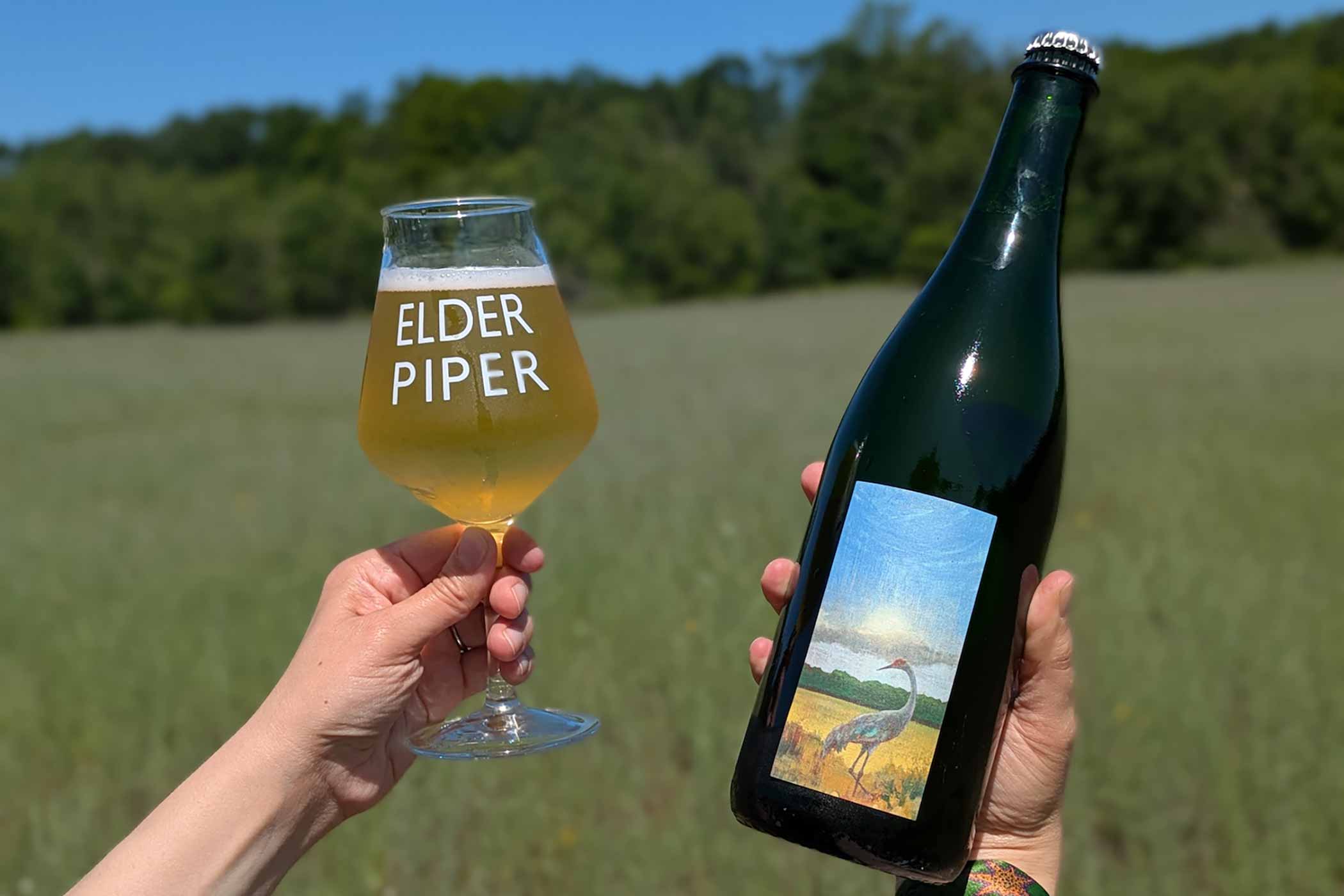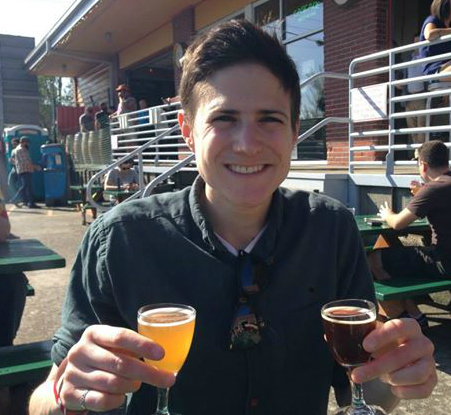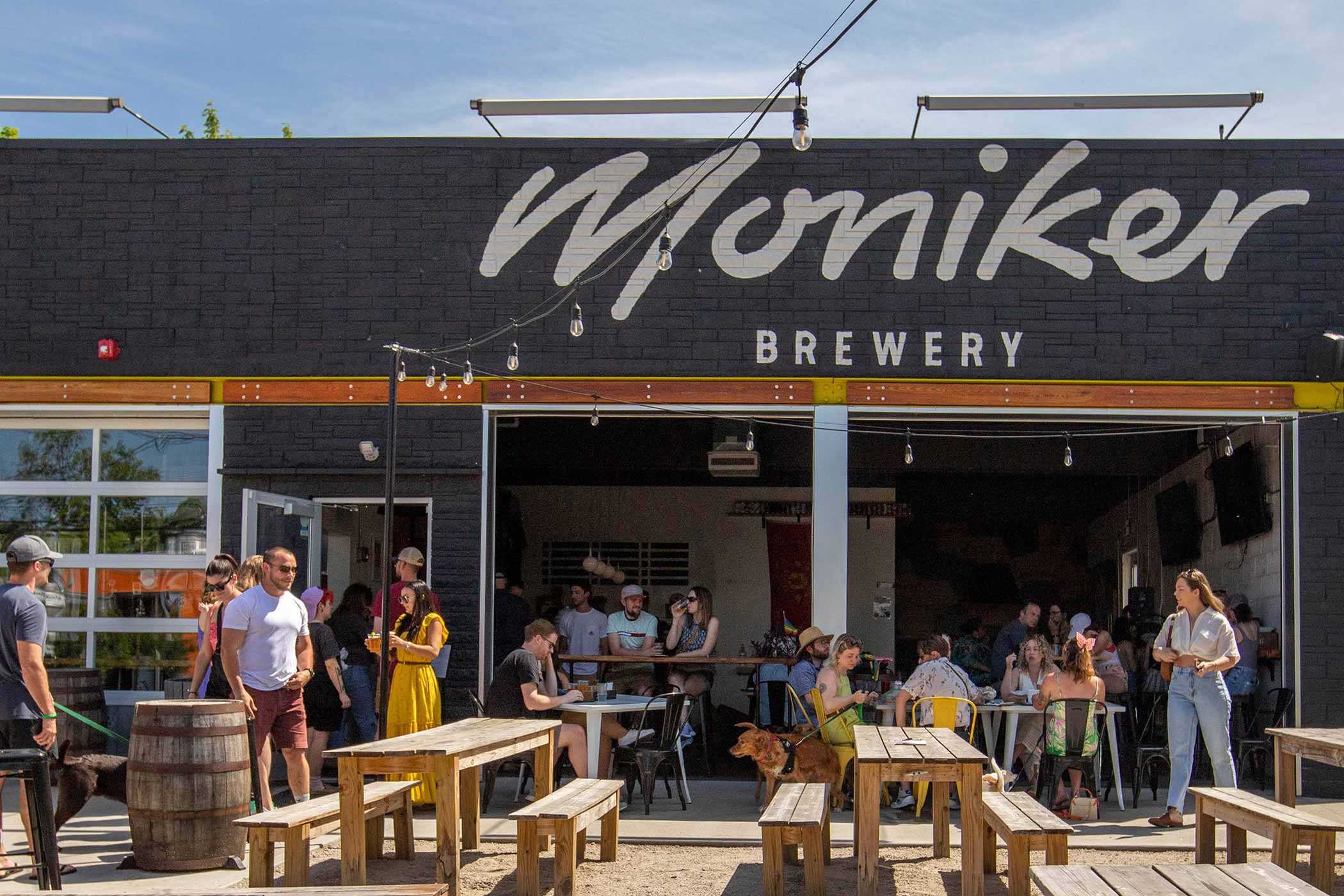Shop
Up North, Home at Last: The Story of Elder Piper Beer & Cider
Lake lager.
Like This, Read That
Up north.
Two little words. But if you know, you know. Growing up in the lake-filled land of Minnesota, my family and I would pack up the car once or twice a year and “head North.” In just a few hours, we left behind towering buildings for towering trees—the sounds of cars humming for loons thrumming on the water. When you’re up north, serenity takes over, a peace that fills the vast silence of a space still untouched by development and diffusion.
Eeva Richmond grew up in Northern Michigan. Petoskey, to be exact. She left home at seventeen, vowing never to return.
But years later, when she started a brewery with her husband Trace Redmond, she only had one place in mind: up north.
Elder Piper Beer & Cider isn’t just a brewery in Northern Michigan. It’s a place people go after a big ice storm to trade tips on how to chop firewood. Where the local gossip is traded like pelts at the general store. It’s where regulars run down the street after Trace and Eeva’s escaped dog, a retired greyhound called Merch.
Seriously, this happened.
“Our regulars were out on their bikes trolling the neighborhood,” shares Eeva while we’re chatting after the July Fourth weekend. “It was one of those real-life moments where people cared not only about the beer but about us as people and our silly, dumb, fast dog who is afraid of the world.”
The very fabric of Elder Piper is stitched together not by machines but by the hands of neighbors, friends, and family. Sewn up with a love for the land and raw Michigan materials, Elder Piper has, stitch by stitch, beer by beer (or cider), and person by person, built a patchwork of personality. All with a side of cider (or beer).
When you’re up north, this is just the way it is.
When you step into Elder Piper’s taproom, it’s as if you’re walking right in Trace and Eeva’s home, sitting down to drink with them as if you were family.
Belgium, Banana Bread, Biology, and Beer
Sometimes to truly understand the meaning of home, you need to leave it.
Eeva left Petoskey right after high school, living as an exchange student with a Flemish family in Antwerp, Belgium.
“I was really interested in getting out of my small town,” she shares. “I wanted to live abroad.”
While living on a new continent, the future brewery owner fell in love with beer.
“In Belgium, beer is such a cultural touchstone,” says Eeva, who learned to speak Flemish during her stay. “I fell in love with the idea of beer as more than a backyard refreshing beverage.”
When she got back to the States, Eeva went to college to study art history. Her freshman fall, she met a self-proclaimed foodie who loves baking and cooking. While making a fresh batch of banana bread in her dorm, Eeva says Trace came in to tell her she was doing it wrong.
“That was our meet-cute,” she laughs.
Trace interjects here with a mild mumble. He didn’t tell her what she was doing wrong, but simply pointed out what she could do better.
“He said you should soak your bananas in coffee overnight and use the coffee as the liquid to add moisture and depth,” admits Eeva. “He was right.”
In college, Trace didn’t just dissect banana bread recipes; he learned how to homebrew with his biology TA. “Which was fun,” the soft-spoken brewer says with a smile. After graduating, Trace worked at Founders and Roak Brewing Company before moving to North Carolina to be Highland Brewing’s R&D brewer.
Eeva followed her art history major by working in museums after graduating. “But I saw how much fun Trace was having in beer,” she says. “It was a culture and a community, and I loved the way it brought folks together; I wanted to be a part of that fun.”
Eeva worked at Roak as well before becoming the lead beer adventurer at Sierra Nevada when the pair moved down south, and eventually the communications and community manager at Highland Brewing.
But despite getting her foot in the door of beer, Eeva always had one dream.
To start her own business.
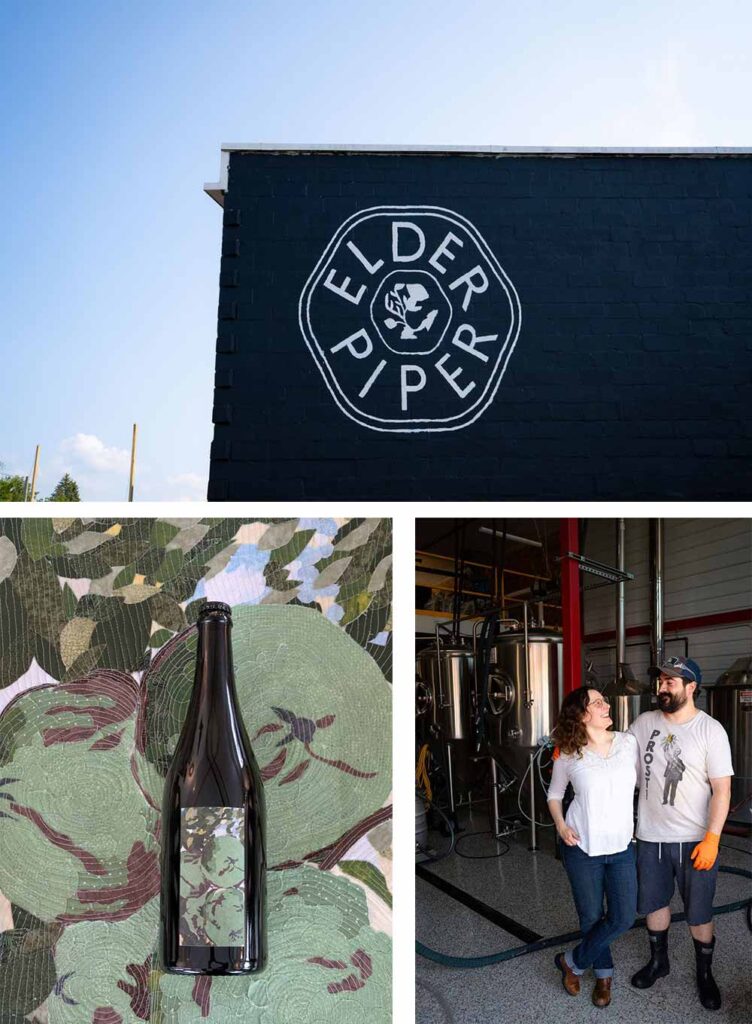
Photography courtesy of Elder Piper Beer & Cider
From Down South to Up North
When Eeva left home for Belgium as a teenager, “I thought I’d never come back to Northern Michigan,” she laughs.
There was just one little problem.
Everywhere the couple moved, Northern Michigan always felt like home. “Nothing else fit that mold,” Eeva explains.
Although originally from Pennsylvania, Trace went to school in Kalamazoo, in Central Michigan, and spent summers studying dune grasses at a biology station in the northern part of the state.
He loved the area, too.
“If we’re going to plant ourselves somewhere,” says Eeva, “we wanted to be in a community we love and care for.”
That has always been Northern Michigan. A place to call home, the North called them home.
Planting a Family Tree

Photography courtesy of Elder Piper Beer and Cider
Home is just a house until people live in it. At Elder Piper, family means everything.
The name Elder Piper comes from the first and last names of some of Trace’s ancestors.
With the physical business an homage to Eeva’s home, a place she loves, the duo wanted the name to reflect Trace’s history, stories, and family. A native of Pennsylvania, Trace’s family has lived in the same county for nine generations.
“Growing up, I just remember in middle school that my gym teacher was my second cousin,” laughs Trace. “It was that [kind of] place.”
Today, at the brewery, you’ll find handmade beer label quilts made by Trace’s mom (who is admittedly more of a wine drinker but loves Elder Pipers’ saisons).
A homey touch in a place that Eeva often describes with just one word.
“Cozy,” she says without hesitation.
Which, for a place Trace and Eeva consider home more than anything, makes sense.
The taproom itself has become much like a natural extension of Petoskey.
Trace and Eeva have upcycled almost everything in the space.
The old 1930s community switchboard station has a quirky shape to it with what Eeva describes as triangular corners. So it’s an intriguing location for the pair’s first brewery.
The natural light initially attracted them. “In a long Michigan winter,” says Eeva, “that’s definitely something you need.”
Anchoring Elder Piper is the bar, what Eeva calls “our showcase piece.” Made from the original one-hundred-year-old ceiling beams, the bar also has some of the old floorboards.
Which also shows up on the window trim.
You’ll find more of those old ceiling beams in a second side bar and lamps throughout the taproom.
“We did cross cuts of them really thin and made lampshades out of them,” says Trace. “So it shines through all the rings on the tree.”
As much as possible, wherever they could, Trace and Eeva kept the buildings’ roots intact in contemporary ways.
They want the space to feel cosy, inviting you in to try something you’ve probably never had before.
“We want them to come in ready to explore with us,” says Eeva. “We make modern fermented beverages that express a taste of place, and that can be a little wild sometimes. And so we wanted people to come at us with curiosity and intrigue and with questions.”
A Michigan Bounty in Every Beer
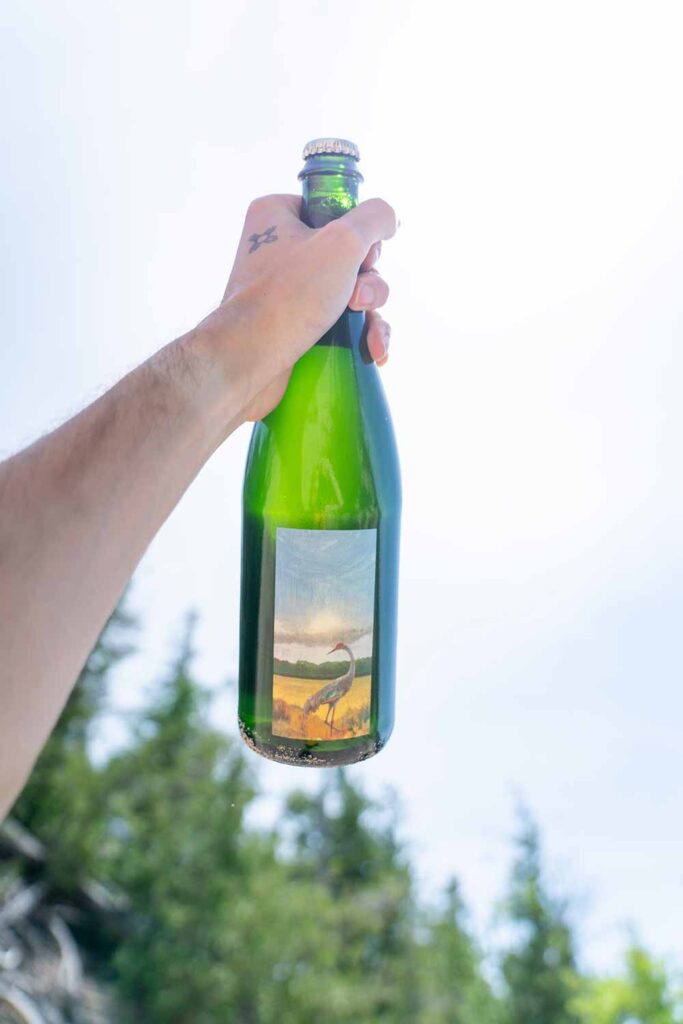
Photography courtesy of Kyler Phillips
Although the name Elder Piper has historic roots, it constantly sparks a growing inquisitiveness.
“We found the name inspires a lot of curiosity,” says Eeva, who often has people coming in and trying to figure out its origins.
One woman bought a shirt just because she has an elderly dog named Piper (which, coincidentally, this beer writer does as well).
Which is exactly how the pair wants people to approach Elder Piper.
The same way they do: with an endless thirst for discovering the world through drink.
Today, Trace approaches brewing at Elder Piper much like he did Eeva’s banana bread recipe, constantly iterating and with an overall respect for the ingredients.
A rich agricultural state, Michigan has a cornucopia of raw materials.
“It’s the second biggest producer of apples in the country and the fourth biggest producer of hops,” Trace enlightens me. Living right to the north of the Fruit Belt outside of Traverse City, Elder Piper has access to cherries, apples, and more.
“I’m trying to showcase that,” explains Trace, who uses a lot of local malt, hops, and fruit. “I try to find ways to show them off in the best way possible.”
For instance, Sandhill Crane, a petite saison released for Elder Piper’s second anniversary. The one hundred percent Michigan malt and hopped saison ferments with an expressive yeast grown in-house, along with different saison yeasts and Brettanomyces. Bottle-conditioned for several weeks, this beer is what Trace calls “a very nerdy version of a light summer beer.”
Overall, Eeva is especially proud of the brewery’s saisons. “I love the way they constantly change and evolve,” says Eeva of the somewhat romantic style. “I’m really proud of the way [our saisons] have created an expression and captured that taste of up north that I’m always trying to chase.”
Trace, on the other hand, continues to chase a very different style of beer: lager.
“The simplicity applies to me,” he says. “You can make a beautiful lager with two ingredients.”
With lagers, there is nothing to hide behind. Rather than the ingredients, it’s the processes that drive these beers, dialing into the finer points of brewing.
“I also really like to drink them,” Trace laughs, admitting that if a pilsner is on tap, he’s probably going to order it.
The first time he brewed a lager at Highland Brewing—a dry-hopped Saaz pilsner—he freaked out. “Because they don’t start fermenting and bubbling right away because it’s a colder and longer fermentation, I came in the next day, and it was barely bubbling,” he remembers. “I thought this was terrible; the beer was ruined.”
Turns out Trace just needed a little patience. Which he practices fully now while making lagers at Elder Piper.
For example, the brewery’s flagship and best-selling beer, Beach Grass. Although a German-style helles, Beach Grass expresses that up-north lifestyle, according to Eeva. “It’s got this wonderful lakeside laidback quality,” she says. “It’s super drinkable.”
Trace uses a Swiss and German lager yeast. The former gives this “lake lager” a nice floral character, which Trace actually found too intense until blended with the German lager yeast. “It does a great job of highlighting the floral character of Noble hops,” says Trace, noting the German hops he uses have a really low alpha acid that contributes to a low IBU despite the aggressive amount he uses—around one pound per barrel. “That helps with the aroma, but also the texture and the feel of the bitterness,” he says.
Trace also uses a very soft water profile for Beach Grass, which he feels just rounds everything out and perfectly fits the style.
If Beach Grass is Elder Piper’s flag planted in the sand, then Shoreline IPA is surely more like a sand castle, an ephemeral structure here one day and gone the next.
A series of seven percent hazy IPAs, Shoreline changes the hops or sometimes even the yeast with each iteration to showcase an exploration of what hoppy beers can be.
“It was inspired by the Michigan shoreline,” says Eeva, “which is constantly changing, yet still the same.”
A project started in February, Elder Piper’s latest Sandhill IPA, released just two days before we spoke, included Nectaron.
But each cycle has been different.
The second batch came out in April after a big ice storm, which took out power to the city and the brewery for five days. Everything shut down. The beer had just finished fermenting by the time Elder Piper got power back. “After four days cooped up, people really wanted to get out,” recounts Eeva. “People came to the brewery just to charge their phones and connect.”
Trace and Eeva named that beer Ice Storm. “It kicked in three days,” says Eeva. “People just wanted a taste of the ice storm.”
Overall, the taste profiles of each Shoreline have resonated with hoppy and non-hoppy drinkers alike.
“A lot of people come in and say, ‘I don’t like IPAs,’” says Eeva before she hands them a taste of Shoreline, telling them, “This is a softer IPA. … It expresses more of the fruitiness of hops and not the bitterness.”
She says those people often leave with their minds changed. “We’re starting to get more people interested in IPAs through that beer!”
The next one in the tank included Motueka, Citra, and Simcoe Cryo. “It’s been smelling like mangoes,” says Trace, who loves how Shoreline gives him the freedom to experiment with new hops and flavor combinations.
This coastal beer gives the pair a chance to keep exploring, learning, and developing their craft.
The love of their land and exploration is also why Trace and Eeva didn’t want to just make beer at Elder Piper.
Apple of Elder Piper’s Eye
Cider just makes sense here.
Trace grew up in an apple-growing region of Pennsylvania. His second-grade teacher owned an orchard and always had bags of apples at school. His mom entered apple pies in local state fairs.
“She’s got some blue ribbons,” Eeva jests playfully. Her family also has ties to the fruit. A family farm about an hour north of Petoskey has an old orchard on it. Every year, Elder Piper makes a natural cider with apples from that orchard.
“That’s just this super cool taste of place,” says Eeva.
Even when he homebrewed, Trace made cider too.
“We’re not approaching cider as secondary to beer,” explains Eeva. “We’ve approached the two as distinct, modern, fermented beverages that we make with their own unique aesthetics.
And it’s worked.
This year, that cider, Pillows & Blankets, took home a bronze in Best in Show in the natural cider category at the Great Lakes International Cider and Perry Competition (GLINTCAP). All told, four Elder Piper ciders medaled this year, a validation especially for Trace, who has felt like he’s been “a brewer pretending to be a cidermaker.”
But after taking a cidermaking course at the Cider Institute of North America last year and now garnering a few medals under his belt, Trace can safely say he’s a brewer and a cidermaker.
Home Is Where the North Is
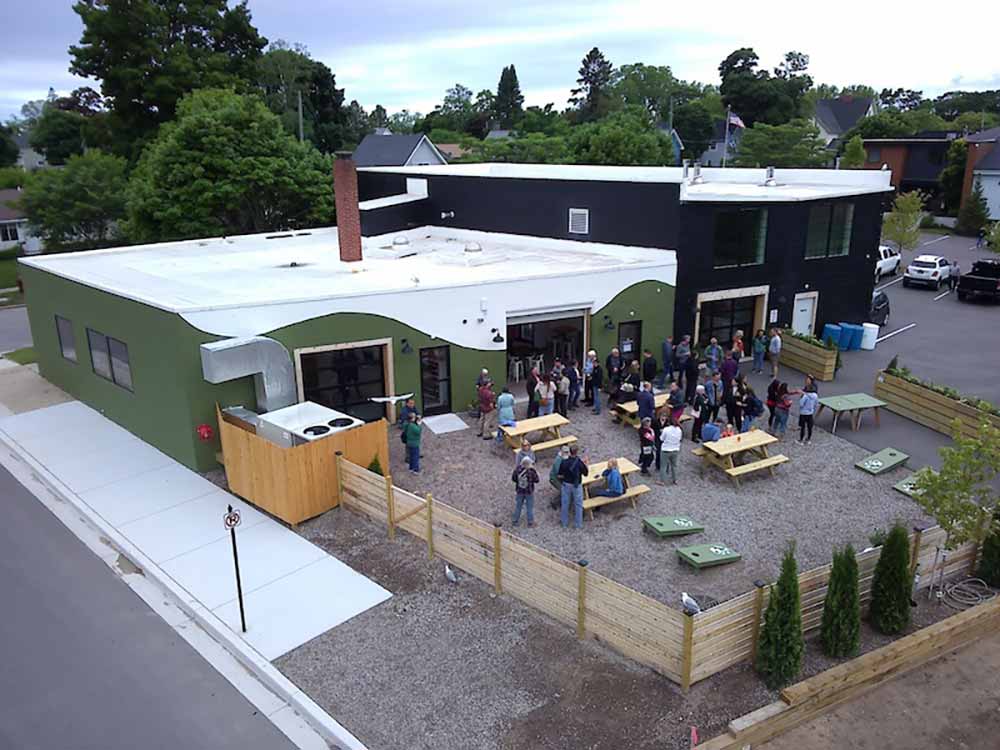
Photography courtesy of Elder Piper Beer & Cider
Recently celebrating its second anniversary, Trace and Eeva reflected on how far they’ve come and where they still hope to go.
Their answers tell you a lot.
Trace wants a canning line and to barrel-age more beer.
Eeva, on the other hand, hopes the brewery can continue to be a home for drinkers in Petoskey and from afar.
“The first year was very much about homecoming and building a community and roots up here in Northern Michigan,” she says. “I would hope that, in the future, we bring our experience, our new perspective from all over the country, all over the world, home. And I hope that in the future, for Elder Piper, we get to share that taste of Northern Michigan, that perspective of up here, with the rest of the country and the rest of the world.”
Pack up the car and head up north. There is not just a new brewery and cidery waiting for you; there’s a new home.

